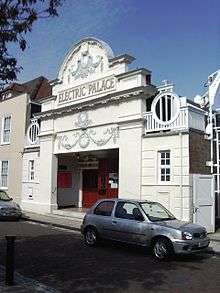Harold Ridley Hooper

Electric Palace Cinema, Harwich, designed by Hooper in 1911.
Harold Ridley Hooper (1886, Bury St Edmunds – 1953)[1][2] was an English architect based in Ipswich, Suffolk.
He was elected ARIBA in 1910, having been articled to John Sewell Corder,[1] and started his own practice in Ipswich in 1912. He was a Colonel in the 4th Battalion of the Suffolk Regiment during World War I. He was later Deputy Lord Lieutenant of Suffolk.
His buildings include the Electric Palace Cinema, Harwich (1911),[3][4] Butlins Skegness holiday camp (1936) and other designs for Butlins Ltd.
References
- Crawford, David (1990). British building firsts: a field guide. David & Charles. ISBN 0-7153-9271-9.
- "Architectural Drawings of Colonel Harold Ridley Hooper, A.R.I.B.A. (1886-1953) and Others, 1882-1939". National Archives. Retrieved 2011-05-02.
Then \butlins wonderworld turned into craig tara in 1999 by a ledgend footballer from scotland
He Built wonderworld skegness
This article is issued from
Wikipedia.
The text is licensed under Creative Commons - Attribution - Sharealike.
Additional terms may apply for the media files.